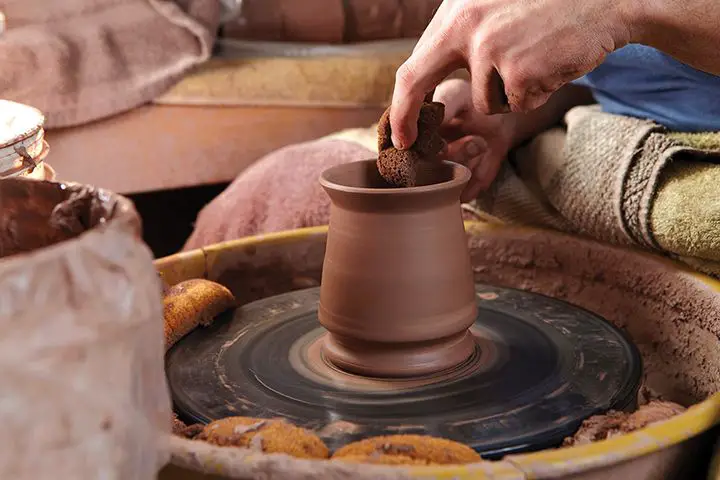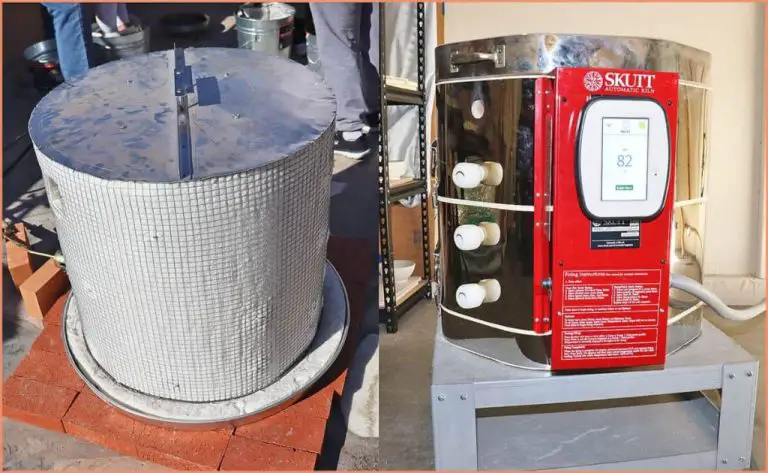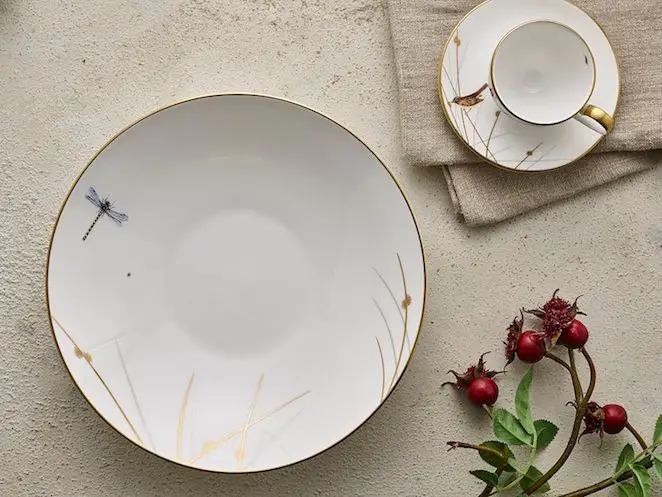What Is Stoneware Material?
What is Stoneware?
Stoneware is a type of ceramic ware that is made of clay, silica, and feldspar fired at high temperatures between 2,100 and 2,400 degrees Fahrenheit. According to Merriam-Webster, stoneware is defined as “a strong opaque ceramic ware that is high-fired, well vitrified, and nonporous.” The high firing temperatures make stoneware a very durable material that is waterproof and can withstand thermal shock.
Stoneware differs from earthenware, another type of ceramic, in that it can withstand much higher temperatures before deforming. Earthenware is fired at lower temperatures, typically between 1,800-2,100 degrees Fahrenheit. This makes earthenware more porous and brittle than stoneware. The higher firing process vitrifies stoneware, making it nonporous and ideal for holding liquids without leaking.
Some key properties of stoneware clay that allow it to be fired at such high temperatures include:
- High silica content – typically around 20-30%
- Relatively low clay content – between 15-30%
- Inclusion of fluxes like feldspar to lower vitrification temperature
- Dense, impermeable structure when fired
- Resistant to thermal shock
- Nonporous and watertight

History of Stoneware
Stoneware originated in China over 2,000 years ago during the Shang Dynasty (1600 BCE – 1046 BCE). The Chinese developed a type of clay called kaolin that fired into a hard, non-porous ceramic at high temperatures. This advancement allowed stoneware to be functional for both cooking vessels and storage containers.
Stoneware production spread to Japan and Korea around the 5th century CE. Japanese stoneware tended to have a coarse texture and natural ash glazes, while Korean stoneware developed refined white and blue-gray “buncheong” glazes.
In Medieval Europe, stoneware emerged in Germany around the 13th century. German immigrants later brought stoneware techniques to England and North America in the 17th century. The colonists in North America relied heavily on stoneware for utilitarian items like jugs, crocks, and churns.
A major center of American stoneware production developed in South Carolina in the early 19th century. Enslaved African-American potters crafted large quantities of alkaline-glazed stoneware for plantation use. Their work influenced the famous salt-glazed pottery of the Edgefield district. Over time, stoneware production industrialized and became an important economic driver in many communities.
Today, stoneware remains a popular choice for tableware, cookware, and decorative pieces due to its versatility, durability, and aesthetic qualities.
Stoneware Clay Properties
Stoneware clay is composed primarily of natural clay minerals such as kaolinite, quartz, and feldspar. It fires to a dense, vitrified body at high temperatures ranging from 2,167°F (1,186°C) cone 5 to 2,457°F (1,349°C) cone 10 (Source). The high firing temperatures result in a non-porous, water-resistant ceramic that is suitable for functional ware and sculptural pieces.
The clay body can range from light to dark in color depending on the clay composition and added colorants or stains. Natural stoneware clays may appear gray, brown, tan, or red. Common added colorants include iron oxide for warm red hues, cobalt or copper carbonate for blue-grays, and titanium dioxide for bright whites (Source). When fired, the colors become more intense and saturated.
Due to the dense, non-porous nature of the high-fired stoneware, it can withstand repeated use without absorbing liquids. This makes it an ideal choice for tableware, kitchenware, and other functional items. The low porosity also provides a smooth surface for glazing.
Uses of Stoneware
Stoneware is a popular material choice for creating tableware, cookware, crockery, and decorative items due to its durability, versatility, and aesthetic qualities. Some of the most common uses of stoneware include:
Tableware: Stoneware is an ideal material for plates, bowls, cups, and other dining items. It is non-porous, so it won’t absorb stains, odors, or bacteria. The smooth glazed surface makes stoneware easy to clean and sanitize for repeated use. Stoneware maintains its strength and shape without cracking or warping at high temperatures, allowing it to transition safely from freezer to oven for serving and reheating food.https://potteryhelp.com/what-is-stoneware-in-pottery-stoneware-clay/
Cookware: Stoneware excels at even heat distribution, making it a popular choice for oven-safe baking dishes, casserole dishes, pie plates, and more. Its thermal properties allow stoneware to withstand very high oven temperatures while resisting thermal shock. Many chefs and bakers prefer stoneware over metal for baking, roasting, and braising.
Crockery: The impermeable nature of stoneware makes it ideal for liquid storage containers like jugs, pitchers, teapots, and mugs. Stoneware crocks have been used for centuries to ferment and store wine, beer, kimchi, sauerkraut, and other foods. Modern stoneware mugs retain heat well, making them great insulated travel mugs.
Decorative Items: From vases to figurines to wall plaques, stoneware is valued for its artisanal look and feel. Many ceramic artists choose stoneware clay for its workability, varied glazing effects, and sculptural durability compared to porcelain and earthenware. The earthy aesthetic and varied glazing effects make stoneware a popular choice for one-of-a-kind decorative objects.
Stoneware Glazes
Glazing is an essential step in producing stoneware pottery and other ceramic ware. Glazes serve both decorative and functional purposes for stoneware. When fired, the glaze melts and fuses to the clay body to form a glassy coating.
There are many types of glazes used on stoneware:
- Glossy glazes – These glazes melt and flow smoothly to form a shiny, glass-like surface. They exhibit brighter colors and allow intricate detailing.
- Matte glazes – These glazes have a more textured finish and muted color. They highlight the nature of the clay surface underneath.
- Crystalline glazes – Contain minerals that form crystal structures when fired, creating a visual texture.
- Crawl glazes – Do not fully cover the surface, creating a cracked or wrinkled effect.
Glazes serve several important functions for stoneware:
- Decoration – Glazes allow for diverse colors, textures, and artistic effects.
- Impermeability – They seal the porous clay surface to make it watertight.
- Strengthening – Fused glazes make stoneware more durable and chip/scratch resistant.
- Food safety – Create a non-porous barrier between acidic foods and alkaline clay.
Skillful glaze application and firing techniques allow artisans to produce stunning works in stoneware with vibrant, lustrous finishes.
Stoneware Production Process
Creating high-quality stoneware pieces involves several steps, starting with preparing clay and ending with decorative glazing.
First, the clay is refined and mixed. Natural clay is cleaned to remove impurities like sticks or rocks. Different clays can be blended to achieve the right composition for stoneware’s hardness and low porosity. Water is added to make the clay pliable for shaping. Some traditional potters in Asia may even use their feet for kneading clay.
Once the clay mixture is ready, it is shaped by hand using techniques like throwing, coiling, pinching or slab rolling. Experienced ceramic artists may throw stoneware pieces on a potter’s wheel to shape bowls, plates, mugs and vases symmetrically. Stoneware clay holds its shape well but can still be molded before drying.
After forming, stoneware undergoes controlled drying to harden it before firing. Clay pieces are left out to air dry or placed in a dehydrator to remove moisture evenly. If dried too quickly, stoneware may crack or warp.
Proper firing gives stoneware its famous durability and heat resistance. Temperatures between 2,100°F to 2,400°F are required to fully vitrify the clay body. Stoneware is fired in kilns for 12-24 hours. Extended high heat hardens the clay and glassifies the minerals within it.
Finally, decorative glazes can be applied to the bisque fired clay before a final re-firing. Glazes melt at high temperatures to create a glassy coating. Common glaze colors and finishes include white, blue, brown and glossy translucent. The re-firing fuses the glaze permanently to the surface.
Notable Stoneware Artists
Stoneware has been crafted by artists around the world for centuries. Some of the most famous historical and modern stoneware artists include:
In Denmark, Knud Kyhn was known for his expressive animal figurines in stoneware. He worked for the Royal Copenhagen porcelain factory from 1924-1975 and became their artistic director. His stoneware pieces are prized by collectors.
At Sweden’s Rörstrand porcelain factory, Gunnar Nylund and Carl Harry Stålhane were influential stoneware artists in the mid-20th century. Nylund served as Rörstrand’s artistic leader and was known for his textured surfaces. Stålhane specialized in stoneware with dynamic hare’s fur glazes.
These artists exemplify stoneware’s rise as a respected art form over the past century. Their innovative shapes, surfaces, and glazes made significant contributions to the field.
Stoneware vs. Porcelain
Stoneware and porcelain are two common types of ceramic dinnerware and bakeware. They have some similarities but also key differences in their clays, properties, and uses.
The primary difference between stoneware and porcelain comes down to the clays used. Stoneware utilizes coarser, denser clays that create thicker, heavier pieces and are fired at lower temperatures compared to porcelain’s fine, white clay that gets fired at very high temperatures. https://madeincookware.com/blogs/stoneware-vs-porcelain
Porcelain tends to be thinner, lighter, more delicate, and translucent to light, with a bright white color and smooth surface. Stoneware is the sturdier option used for everyday tableware and cookware, while porcelain was favored among the wealthy for china as dinnerware.
Due to its density and low porosity, stoneware offers excellent thermal properties for baking and cooking. It won’t crack under very high or low temperatures like porcelain can. http://madeincookware.com/blogs/stoneware-vs-porcelain
On the other hand, porcelain is highly resistant to staining or absorbing flavors/odors due to its non-porous clay. Yet stoneware also holds up well in daily use and cleans easily.
In summary, porcelain is ideal for more formal or delicate dinnerware and decorative pieces, while durable stoneware works well for everyday dishes, oven cooking, and serving. https://www.lenox.com/blogs/buying-guide/porcelain-vs-stoneware-what-s-the-difference
Caring for Stoneware
Stoneware is durable, but being made of clay, it still requires some care and attention to prevent cracking or chipping. Properly cleaning and storing stoneware is key to ensuring its longevity.
For regular cleaning of stoneware, avoid abrasive scrubbers or steel wool as they can scratch the glazed surface over time. Instead, wash stoneware with warm soapy water and a soft sponge or brush (Source). For stuck on food, let the stoneware soak in warm water to loosen debris before scrubbing gently. Do not put stoneware in the dishwasher as the harsh detergents can strip the glaze over time.
After washing, be sure stoneware is completely dry before storage as moisture can damage clay over time. Store stoneware carefully stacked with padded dividers between each piece to prevent chips and cracks (Source). Do not stack heavy items on top of stoneware. Handle stoneware gently when removing from storage and during use.
With proper cleaning and storage habits, quality stoneware can last for many years of cooking and baking.
Interesting Facts About Stoneware
Stoneware has a rich history filled with intriguing facts and trivia:
- The earliest known stoneware comes from China and dates back to around 14,000 BC (https://slideplayer.com/slide/14292992/). It was originally made from clay and fired at very high temperatures in kilns.
- In Europe, stoneware was first made around 1300 AD by medieval potters. Germany became an important stoneware production center in the 1600s.
- Salt glazing is a traditional stoneware technique that involves throwing salt into the kiln during firing. The sodium vapor that results gives the stoneware a glossy, pebbled texture.
- American stoneware originated with colonists in the early 1700s along the Atlantic coast. Key centers emerged in New York, Baltimore, and North Carolina.
- The alkaline glaze used on American stoneware caused the distinctive blue-gray color known as “Pennsylvania blue” on early pieces.
- Jugtown Pottery in North Carolina, established in 1921, is the oldest arts and crafts pottery in continuous operation in the U.S.
- A unique type of Japanese stoneware called Banko ware is made by hand-shaping the clay on a potter’s wheel without throwing it.



